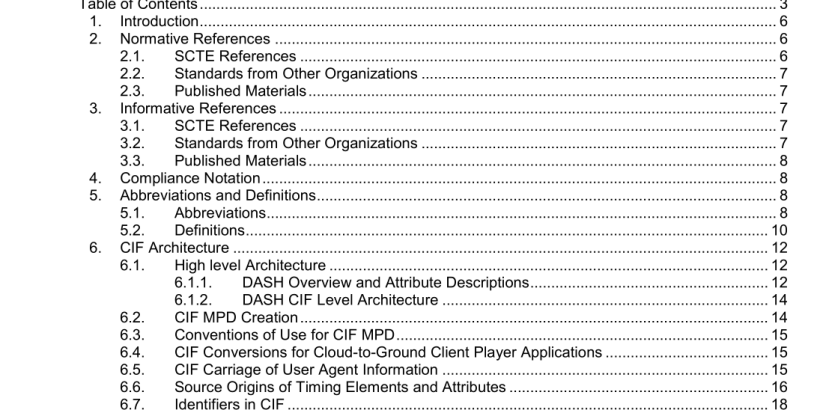ANSI SCTE 214-4-2018 pdf download.MPEG DASH for IP-Based Cable Services
6.1. High level Architecture
The CIF Specification describes the manifest presentation description for an MPEG-TS linear stream or stored file. Through the manifest, a CIF Client (e.g. a Packager or Transcoder) can request one or more particular section(s) of the MPEG-TS file or stream. To standardize the details in the manifest, the DASH standard [8] is used as it describes a rich and precise vocabulary for manifest description. In the DASH taxonomy, representation conceptually means single media (one or more elementary streams), comprised of multiple short segments . An adaptation set is a set of seamlessly switchable representations, and a period is a time box within which representations exist. Each period can be viewed as an independent playlist (similar to a master m3u8 in HLS) or a completely different program, and a period border can be seen as a splice point. Using CIF MPDs does not require end-customer DASH clients. Packagers will retrieve content based on CIF MPD, and create client manifests of appropriate technology (HLS, DASH, HDS, HSS) as shown in Figure 3. A linear packager may ingest an ATS stream [6] and output a segmented DASH-TS stream, while parsing the stream to create a CIF MPD for the stream. A downstream packaging device may be used to retrieve specific segments from a content asset based upon cache miss request from a CDN or a client request for cDVR material.
6.1.1. DASH Overview and Attribute Descriptions
The DASH standard provides a method for retrieving media segments [8]. The authors of DASH included participation from Apple and Microsoft, who contributed the MPEG2-TS Live and ISO-BMFF Live Profiles respectively. These two profiles are used as examples by which the HLS and HSS ABR Fragments/Segments are indexed. In current applications, the DASH standard [8] is used for server (an HTTP server) – client distribution of media to an end customer. A DASH MPD [8] describes the construction of a URL for each DASH segment. DASH segments are indexed by time or segment number and described by a number of properties including bitrate, codec, and resolution. A DASH client [8] is capable of processing an MPD and performing HTTP GET requests to retrieve a media asset. MPDs should be compressed during transfer using the gzip transfer encoding toolset that is part of the HTTP 1.1 server. Use of other compression tools for MPD transfer other than those specified in HTTP 1.1 is strongly discouraged to avoid complexities in maintaining toolset updates across servers.
In the CIF architecture case, the current application is expanded to include the use of DASH-like structures to deliver media segments to downstream devices in the network. The JIT packager or other intra-network downstream CIF client uses a DASH-like MPD to find and request segments from the file or linear stream for further segment and manifest processing. Modifications to the CIF MPD are needed so that relevant information contained in the CIF MPD can be converted to a compliant client manifest used by a DASH or HLS client. The CIF client packager creates a client manifest from the CIF MPD for the client player in one or more formats: HLS, HDS, HSS, ISO-BMFF DASH, or less commonly MPEG- TS DASH. The CIF MPD is used by the packager to retrieve DASH segments from an internal facing network storage system and to create the appropriate client manifest for the specific type of end client player.ANSI SCTE 214-4-2018 pdf download
